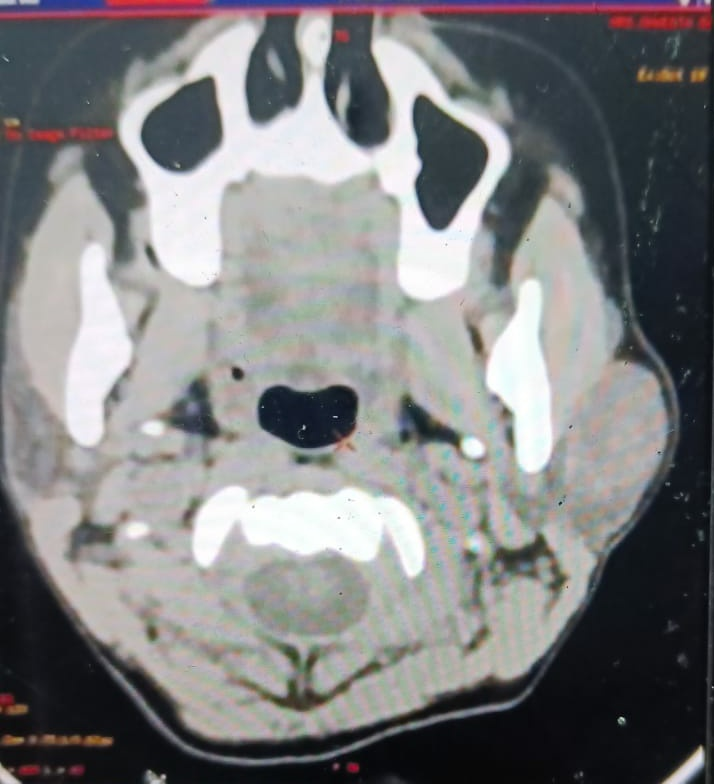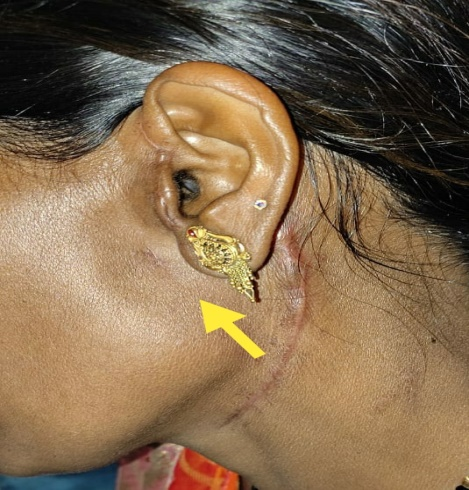MC Prasant1, Pavan Tenglikar2, Ziyauddin2*, Rohit Kumar Singh2, Shiv Pratap Singh2, Shreya Chouksey3
1Professor and HOD, Department of Oral and Maxillofacial Surgery, RKDF Dental College, Bhopal, Madhya Pradesh, India
2PG Resident, Department of Oral and Maxillofacial Surgery, RKDF Dental College, Bhopal, Madhya Pradesh, India
3PG Resident, Department of Prosthodontics and Crown and Bridge), Hitkarni Dental College and Hospital, Jabalpur, Madhya Pradesh, India
*Corresponding Author: Ziyauddin, PG Resident, Department of Oral and Maxillofacial Surgery, RKDF Dental College, Bhopal, Madhya Pradesh, India; Email: [email protected]
Published Date: 22-02-2022
Copyright© 2022 by Ziyauddin, et al. All rights reserved. This is an open access article distributed under the terms of the Creative Commons Attribution License, which permits unrestricted use, distribution, and reproduction in any medium, provided the original author and source are credited.
Abstract
Pleomorphic adenomas are the most commonly occuring benign salivary gland tumors, mainly affecting the superficial lobe of the parotid gland and among the minor salivary glands the most common sites are palate, lips and cheek. Rarely involves floor of mouth, tongue, throat, nasal cavity, etc. It is also known as bening mixed tumour on the basis of its epithelial and connective tissue origin. Here we report an interesting case aiming to throw light on Pleomorphic adenoma of left side parotid gland. Wide local excision was suggested treatment of choice under general anesthesia.
Keywords
Pleomorphic Adenoma; Bening Salivary Gland Tumour; Parotidectomy; Parotid Gland
Introduction
The term “Pleomorphic Adenoma”was first coined by Willis in 1972. Pleomorphic adenoma is a benign salivary gland tumour with malignant potential. It is characterized by neoplastic growth of parenchymatous glandular cells and myoepithelial components. It’s the most frequent type of salivary gland tumour, as well as the most common parotid gland tumour. The architectural Pleomorphism (variable appearance) seen by light microscopy gave it its name [1]. It’s also characterised as a “Mixed tumour, salivary gland type,” which alludes to its epithelial and myoepithelial origins rather than its pleomorphic look. Most typically affects the parotid gland (90 %) and minor salivary glands (10 %). Female inclination is noted (Female: Male = 2:1). Pleomorphic adenoma is usually solitary and presents as slow-growing asymptomatic swelling with a mean age of 44 years [2].
Case Report
A 42 years old female patient reported to the Department of Oral and Maxillofacial surgery, RKDF Dental College and Research Center, Bhopal with a chief complaint of slow growing, painless swelling on the left side of face since 5 years. The swelling was initially small in size and had progressively increased with time to attain the present size. Past medical and surgical history was noncontributory. Extra-oral clinical examination revealed a marked facial asymmetry. A well-defined, ovoid, swelling, 3.2 (CC) x 3.1(AP) x 2.3(TR) cm in diameter was seen on the left side of the face. A well-defined solid lesion in anterosuperior aspect of superficial lobe of left parotid gland with preserved surrounding fat planes (Fig. 1).
Few enlarged lymph nodes of size 1.6 * 8 cm with maintained fatty hilum seen in IB and IIA cervical lymph node. The left ear lobule was slightly everted. Loss of wrinkling of the skin and engorged veins was also seen. She did not have any difficulty with speech and deglutition [2,3]. It was firm, with no fixation. No facial paralysis was noticed. On general examination, all other vital signs were within normal range. FNAC was performed but was not confirmatory. An incisional biopsy was done (Fig. 2). An irregular mass with well-defined borders having an incomplete fibrous capsule was obtained. Cut surface was rubbery [4]. On palpation the swelling was sessile, firm in consistency, no tender, no fluctuant, no reducible, no pulsatile and mobile in all planes with well-defined margins. Intraoral examination was unremarkable.
A provisional diagnosis of benign tumor of the left parotid gland was taken into consideration. Pleomorphic adenoma, Warthin’s tumor and neuroma of the facial nerve (nerve sheath tumor) were considered as the most probable differential diagnosis.
Panoramic radiographic examination did not reveal any abnormality. Computed tomography (CT) image revealed a well-defined solid lesion of (3.2 (CC) x 3.1(AP) x 2.3(TR) cm) seen in anterosuperior aspect of superficial lobe of parotid gland. Rest of the superficial and deep lobes of left parotid gland are normal in size and intensity. Multiple small oval shaped bilateral level IB and IIA cervical lymph nodes are seen (left>right) with preserved central fatty hilum, largest one measures 1.8*0.7 cm. Right parotid and bilateral submandibular and sublingual gland are normal. The sternocleidomastoid, digastric and strepius muscles are normal [5]. Subcutaneous fat planes and other soft tissue structures are normal (Fig. 3-5).
Patient was then subjected for the routine hematological investigations and findings were found to normal.

Figure 1: (A)-Frontal View and (B)-Lateral View of face showing left sided facial swelling.

Figure 2: CT scan showing well defined enhancing lesion of left parotid gland.

Figure 3: (A)- Exposure of the lesion and (B)-Excision of the lesion.

Figure 4: Excised specimen.

Figure 5: Postoperatively after 3 months showing no deformity.
Discussion
Pleomorphic adenomas are the most frequent benign salivary gland tumours, affecting primarily the superficial lobe of the parotid gland and the palate, lips and cheek among the minor salivary glands. It rarely affects the floor of the mouth, tongue, throat, nasal cavity and other areas. Because of its epithelial and connective tissue origins, it’s also known as a Bening mixed tumour. Females are more likely than males to be affected. The tumour is usually solitary and appears as a slow-growing, painless, firm single nodular mass ranging in size from 3.2 (CC) x 3.1(AP) x 2.3(TR) cm in diameter. Rather than a multinodular appearance, isolated nodules are usually outgrowths of the primary nodule. It is normally migratory unless discovered in the palate and when found in the parotid gland, it can induce atrophy of the mandibular ramus. The ear lobe may be elevated if the tumour is located in the parotid tail. Pleomorphic adenomas, albeit categorised as benign tumours, have the ability to grow to vast sizes and can turn into carcinoma pleomorphic adenoma if they become malignant. Pleomorphic adenomas have a malignant transformation rate ranging from 1.9 % to 23.3 % [5]. Tumors with a longer history, recurrences, increased age of the patient and location in a large salivary gland have a higher chance of recurrence. Because 90% of pleomorphic adenomas occur in the superficial lobe of the parotid gland, superficial parotidectomy with facial nerve preservation is the preferred treatment. Because of the tumour size, large pleomorphic adenomas can be treated with total parotidectomy. Because recurrence might happen up to 30 years after treatment, a post-operative examination of the patient is required with regular follow-up [6].
Conclusion
Pleomorphic adenoma, despite being a benign salivary gland tumour, could be discovered early and surgically remove. When actions with the parotid gland, care should be identified to maintain the facial nerve. To avoid recurrence and malignant change, the lesion must be completely removed.
Acknowledgement
Department of Oral and Maxillofacial Surgery, RKDF Dental and Medical College and Research Center, Bhopal, Madhya Pradesh for the valuable support.
Conflict of Interest
The authors declare no conflict of interest exists.
References
- Cohen EG, Patel SG, Lin O, Boyle JO, Kraus DH, Singh B, et al. Fine-needle aspiration biopsy of salivary gland lesions in a selected patient population. Arch Otolaryngol-Head & Neck Surg. 2004;130(6):773-8.
- Dalati T, Hussein MR. Juvenile pleomorphic adenoma of the cheek: a case report and review of literature. Diag Pathol. 2009;4(1):1-5.
- Sunil S, Gopakumar D. Pleomorphic adenoma. A case report and review of literature. Int J Odontostomat. 2013;7(2):171-4.
- Jain S, Hasan S, Vyas N, Shah N, Dalal S. Pleomorphic adenoma of the parotid gland: report of a case with review of literature. Ethiopian J Health Sci. 2015;25(2):189-94.
- Periasamy S, Manoharan A, Garg H, Kumar SP. Pleomorphic adenoma of the cheek: a case report. Cureus. 2019;11(8).
- Almeslet AS. Pleomorphic adenoma: a systematic review. Int J Clin Pediatric Dent. 2020;13(3):284.
Article Type
Case Report
Publication History
Received Date: 28-01-2022
Accepted Date: 15-02-2022
Published Date: 22-02-2022
Copyright© 2022 by Ziyauddin, et al. All rights reserved. This is an open access article distributed under the terms of the Creative Commons Attribution License, which permits unrestricted use, distribution, and reproduction in any medium, provided the original author and source are credited.
Citation: Ziyauddin, et al. A Case of Pleomorphic Adenoma at Superficial Lobe of Left Parotid Gland. J Dental Health Oral Res. 2022;3(1):1-7.

Figure 1: (A)-Frontal View and (B)-Lateral View of face showing left sided facial swelling.

Figure 2: CT scan showing well defined enhancing lesion of left parotid gland.

Figure 3: (A)- Exposure of the lesion and (B)-Excision of the lesion.

Figure 4: Excised specimen.

Figure 5: Postoperatively after 3 months showing no deformity.


